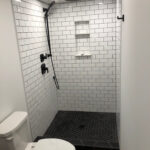
Key Considerations When Remodeling A Bathroom
August 28, 2024
Bathroom Remodeling Success: How to Achieve It
November 1, 2024Renovating your kitchen is one of the most rewarding ways to update your home, providing a fresh, modern look while improving functionality and efficiency. A kitchen remodel doesn’t just enhance the beauty of your home but also increases its overall value. However, such a significant project requires careful planning to avoid common pitfalls and ensure the process goes as smoothly as possible. Belmont Restoration offers expert tips and ideas for planning a successful kitchen renovation serving the greater Minnetonka Minnesota area.
How Long Should You Spend on Planning Your Kitchen Remodel?
One of the first questions many homeowners ask is how long they should spend planning their kitchen remodel. According to the National Kitchen and Bath Association (NKBA), at least six months should be dedicated to the planning stage. This timeframe might seem long, but careful and thorough planning is essential for several reasons:
- Prevents costly design changes during construction: Sudden changes in design after construction has begun can lead to major expenses and delays. A solid plan minimizes the need for on-the-fly alterations.
- Allows for better budget management: Taking time to plan allows you to carefully outline your budget and anticipate where your money will go, helping you avoid overspending.
- Enhances efficiency: With a well-thought-out plan, the renovation can proceed more smoothly, reducing delays and hiccups.
- Provides flexibility for the best timing: Careful planning allows you to choose the ideal time of year for your renovation, ensuring it aligns with your schedule.
Spending six months on planning may seem lengthy, but in the long run, it helps avoid surprises, minimize stress, and allow you to devise contingency plans for any unexpected issues that may arise during the remodel.
Essential Planning Tips for Your Kitchen Remodel
A kitchen remodel can be overwhelming, but breaking it down into manageable steps makes the process smoother. Here are some essential tips to help guide your planning process:
- Take exact measurements of your current kitchen:
- Measure walkways, doorways, counters, and all key elements to ensure that new fixtures, cabinetry, and appliances will fit perfectly. Precise measurements are critical to avoid design flaws and last-minute changes.
- Study your kitchen’s ideal traffic patterns:
- The flow of traffic in your kitchen is crucial for creating an efficient workspace. As a general rule, aim for at least 42 inches of space between work aisles, and if there are multiple cooks in your household, increase this to 48 inches. Ensuring proper flow will prevent congestion and make cooking easier.
- Prioritize ergonomics:
- The comfort and accessibility of your kitchen should be top of mind. Consider adding features like pull-out shelves, lazy Susans, wall ovens instead of ranges, and adjustable counter heights. These small details can greatly improve the ease of use, especially for those with mobility challenges.
- Select materials, fixtures, and appliances early:
- Before any work begins, decide on your materials, fixtures, color palette, and appliances. This will help you stick to your budget and avoid delays caused by backordered items or indecision. With everything picked out in advance, your contractor can move forward without waiting on supplies.
- Consulting a professional designer:
- If your renovation is extensive or you feel unsure about the design process, working with a professional designer can make a big difference. They can help you visualize the final look, suggest efficient layouts, and prevent costly design errors.
Prevent Common Kitchen Remodeling Mistakes
Careful planning also helps you avoid common kitchen remodeling mistakes that could derail your project and cost you more time and money than anticipated. Here are some errors you can sidestep with proper foresight:
- Neglecting the kitchen workflow: One of the most critical elements of kitchen design is the workflow between the sink, stove, and refrigerator—the three busiest areas in the room. These should form a “work triangle,” with each positioned a reasonable distance apart to allow for smooth movement between tasks. Placing them too close together or far apart can hinder your kitchen’s functionality.
- Delaying the selection of appliances: Appliances are key elements that dictate the layout of your kitchen. You’ll need to know their dimensions and placement early on to ensure your cabinets and storage solutions fit around them perfectly. Waiting until the last minute to choose appliances can result in a poor fit and a disjointed design.
- Changing your mind too often: Once construction begins, it’s important to stick with the plan. Changing your mind frequently during the project can lead to frustration, unexpected expenses, and significant delays. This is why thorough planning is so important—you’ll have time to carefully consider your options and make informed decisions before any work starts.
- Overlooking the small details: While it’s easy to get caught up in major decisions like cabinetry, countertops, and flooring, don’t forget about the smaller details like cabinet hardware, lighting fixtures, and backsplashes. These elements can have a big impact on the overall look and functionality of your kitchen, so they should be considered early in the planning process.
By addressing these potential issues during the planning phase, you can avoid costly mistakes and ensure that your kitchen remodel is a success.
Final Thoughts
A kitchen remodel is a major project that requires thoughtful planning and careful consideration of both aesthetics and functionality. Dedicating time to the planning process, following essential tips, and avoiding common mistakes will lead to a smoother, more enjoyable renovation. By doing so, you’ll create a beautiful, efficient kitchen that meets your family’s needs and enhances your home for years to come. For all of you residential renovations contact Belmont Home Remodeling serving the Twin Cities MN area.



